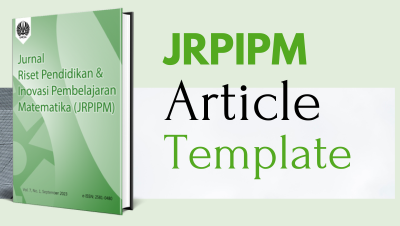Mathematical Numeracy Literacy Ability of High School Students in Solving Math Problems
DOI:
https://doi.org/10.26740/jrpipm.v8n2.p141-150Keywords:
Literacy, Numeration, Matter levelAbstract
As the low mathematical connection problem shows, students are unable to make mathematical connections on their own. Thus the ability to make mathematical connections is very necessary for training students. This study aims to describe students' mathematical numeracy literacy skills using AKM questions with adapted PISA standards and the difficulties faced by students in solving the given questions. The subjects of this study were grade XI students of SMA Wachid Hasyim 2 Taman Sidoarjo who were selected in one class with a total of 28 students. The type of research used in this study is Mixed Methods Research. The techniques used in this study are test techniques to determine students' ability to solve math numeracy literacy problems, questionnaire techniques to find out students' difficulties, and interviews for in-depth examinations. From the results of the study, it was found that level 1 and 2 category questions were very good, students were able to provide explanations in the form of mathematics and use simple procedures to solve problems. In level 3 and 4 category questions are sufficient, students are still able even though they are not optimal in understanding concepts, representing, and designing solving strategies. On the level 5 question, the category is less. This is because students are less able to represent, reflect, and communicate questions properly and correctly. Level 6 category questions are lacking because students have not been able to apply and master technical mathematical operations, develop new strategies and approaches to deal with new situations, and communicate well. The biggest difficulty faced by students is in analyzing problems, representing, designing solving strategies, accuracy of calculations, and communicating them with argumentation.
References
Afandi, A. (2018). Difference of learning mathematics between open question model and conventional model. Malikussaleh Journal of Mathematics Learning (MJML), 1(1), 13. https://doi.org/10.29103/mjml.v1i1.620
Akınoğlu, O., & Tandoğan, R. Ö. (2007). The Effects of Problem-Based Active Learning in Science Education on Students’ Academic Achievement, Attitude and Concept Learning. Eurasia Journal of Mathematics, 3(1), 71–81.
Balestra, C., & Tonkin, R. (2018). OECD Statistics Working Papers 2018/01 Inequalities in household wealth across OECD countries: Evidence from the OECD Wealth Distribution Database. https://doi.org/10.1787/7e1bf673-en
Elwijaya, F., Harun, M., & Helsa, Y. (2021). Implementasi Pendekatan Realistic Mathematics Education (RME) di Sekolah Dasar. Jurnal Basicedu, 5(2), 741–748. https://doi.org/10.31004/basicedu.v5i2.796
Garofalo, J., Drier, H., Harper, S., Timmerman, M. A., & Shockey, T. (2000). Promoting appropriate uses of technology in mathematics teacher preparation.
Gravemeijer, K. (2013). Revisiting ‘ Mathematics education revisited .’ Freudental 100, 24, 106–113.
Gravemeijer, K., & Cobb, P. (2006). Design research from a learning design perspective. In Educational Design Research (pp. 18–51).
Hasbi M., L. A., & Sulaiman, R. (2019). The Realistic of Mathematic Educational Approach to Enhancing Ability Mathematical Connections. International Journal of Trends in Mathematics Education Research, 2(4), 179–183. https://doi.org/10.33122/ijtmer.v2i4.82
Istiroha, I. (2023). Penerapan Pendekatan Realistic Mathematics Education untuk Meningkatkan Kemampuan Berpikir Kreatif Matematika Siswa Kelas IX.E SMP Negeri 12 Mataram. Yasin, 3(2), 308–321. https://doi.org/10.58578/yasin.v3i2.1074
Jupri, A., & Drijvers, P. (2016). Student difficulties in mathematizing word problems in Algebra. Eurasia Journal of Mathematics, Science and Technology Education, 12(9), 2481–2502. https://doi.org/10.12973/eurasia.2016.1299a
Mahmud, M. R., & Pratiwi, I. M. (2019). Literasi Numerasi Siswa Dalam Pemecahan Masalah Tidak Terstruktur. KALAMATIKA Jurnal Pendidikan Matematika, 4(1), 69–88. https://doi.org/10.22236/kalamatika.vol4no1.2019pp69-88
Masitoh, S. (2018). Blended Learning Berwawasan Literasi Digital Suatu Upaya Meningkatkan Kualitas Pembelajaran dan Membangun Generasi Emas 2045. Proceedings of The ICECRS, 1(3). https://doi.org/10.21070/picecrs.v1i3.1377
Nurani, N. I., & Maula, L. H. (2020). Analisis Proses Pembelajaran Matematika Berbasis Daring Menggunakan Aplikasi Google Classroom pada Masa Pandemi Covid-19. Jurnal PGSD, 6(1). https://e-journal.umc.ac.id/index.php/JPS
Rifqi, S. (2019). Menyusun instrumen penilaian untuk pembelajaran topik lingkungan berorientasi literasi saintifik.
Siskawati, F. S., Chandra, F. E., & Khairun, U. (2024). THE EFFECT OF NUMERACY LITERACY SKILLS ON VERBAL AND WRITTEN COMMUNICATION SKILLS. 1, 173–183.
Trisnawati T., P. R., & Waziana, W. (2018). The effect of realistic mathematics education on student’s mathematical communication ability. Malikussaleh Journal of Mathematics Learning (MJML), 1(1), 31. https://doi.org/10.29103/mjml.v1i1.741
Willems, J. L., de Medina, E. O. R., Bernard, R., Coumel, P., Fisch, C., Krikler, D., & Wellens, H. J. (1985). Criteria for intraventricular conduction disturbances and pre-excitation. J Am Coll Cardiol, 5(6), 1261–1275. https://doi.org/10.1016/S0735-1097(85)80335-1
Downloads
Published
How to Cite
Issue
Section
 Abstract views: 238
,
Abstract views: 238
, PDF Downloads: 240
PDF Downloads: 240






